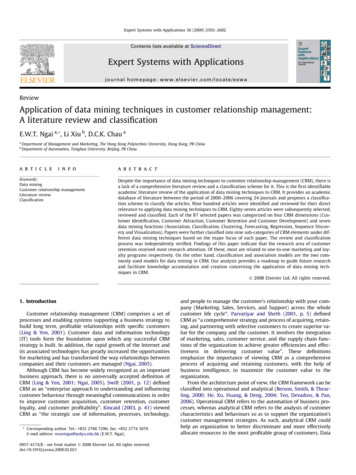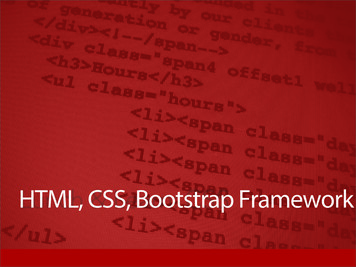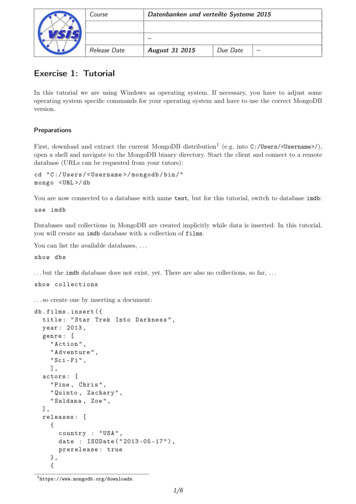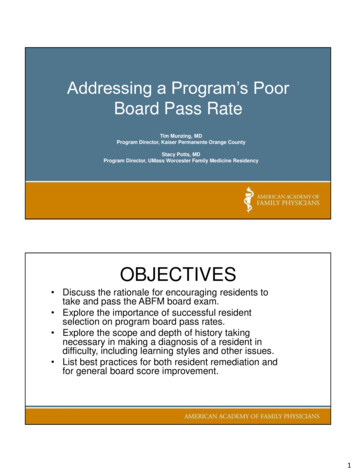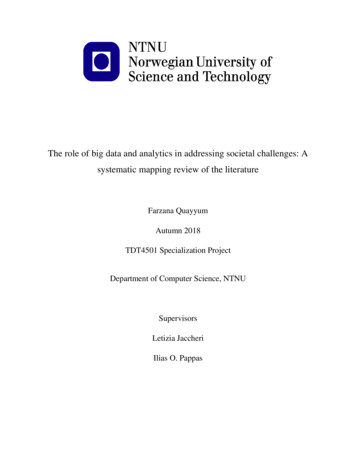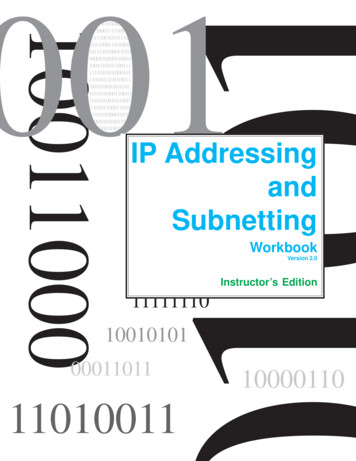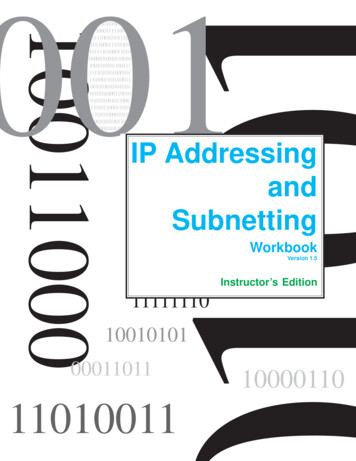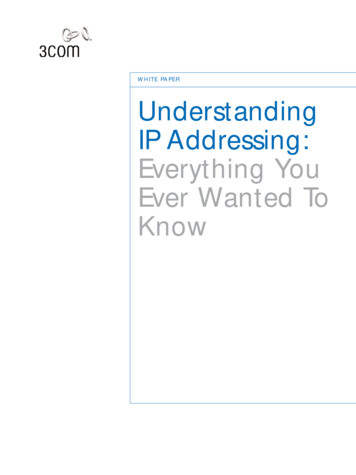
Transcription
W H I T E PA P E RUnderstandingIP Addressing:Everything YouEver Wanted ToKnow
Understanding IP Addressing: EverythingYou Ever Wanted To KnowCONTENTSInternet Scaling Problems1Classful IP Addressing3Subnetting7Variable Length Subnet Masks (VLSM)18Classless Inter-Domain Routing (CIDR)31New Solutions for Scaling the Internet Address Space39IPv6 Resolves IPv4 Issues42Additional IPv6 Features49Keeping Current on Internet Addressing Issues50Appendix A - References52Appendix B - Classful IP Addressing55Appendix C - Subnetting Exercises57Appendix D - VLSM Exercise61Appendix E - CIDR Exercises66III
Understanding IP Addressing:Everything You Ever Wanted To KnowThe Internet continues to grow at a phenomenal rate. This is reflected inthe tremendous popularity of the World Wide Web (WWW), the opportunities that businesses see in reaching customers from virtual storefronts,and the emergence of new ways of doing business. It is clear that expandingbusiness and public awareness will continue to increase demand for accessto resources on the Internet.Internet Scaling ProblemsOver the past few years, the Internet has experienced two major scalingissues as it has struggled to provide continuous and uninterruptedgrowth: The eventual exhaustion of IP version 4 (IPv4) address space The need to route traffic between the ever increasing number of net-works that comprise the InternetThe first problem is concerned with the eventual depletion of the IPaddress space. IPv4 defines a 32-bit address which means that there areonly 232 (4,294,967,296) IPv4 addresses available. As the Internet continues to grow, this finite number of IP addresses will eventually beexhausted.The address shortage problem is aggravated by the fact that portions ofthe IP address space have not been efficiently allocated. Also, the traditional model of classful addressing does not allow the address space tobe used to its maximum potential. The Address Lifetime Expectancy(ALE) Working Group of the Internet Engineering Task Force (IETF) hasexpressed concerns that if the current address allocation policies are notmodified, the Internet will experience a near to medium term exhaustion of its unallocated address pool. If the Internet’s address supplyproblem is not solved, new users may be unable to connect to the globalInternet. More than half of all possible IPv4 addresses have beenassigned to ISPs, corporations, and government agencies, but only anestimated 69 million addresses are actually in use.F I G U R E 1 . N e t w o r k N u m b e r G ro w t h1
The second problem is caused by the rapid growth in the size of theInternet routing tables. Internet backbone routers are required to maintain complete routing information for the Internet. Over recent years,routing tables have experienced exponential growth as increasing numbers of organizations connect to the Internet. In December 1990 therewere 2,190 routes, in December 1995 there were more than 30,000routes, and in December 2000 more than 100,000 routes.F I G U R E 2 . G ro w t h o f I n t e r n e t R o u t i n g Ta b l e sUnfortunately, the routing problem cannot be solved by simplyinstalling more router memory and increasing the size of the routingtables. Other factors related to the capacity problem include the growing demand for CPU horsepower to compute routing table/topologychanges, the increasingly dynamic nature of WWW connections andtheir effect on router forwarding caches, and the sheer volume of information that needs to be managed by people and machines. If the number of entries in the global routing table is allowed to increase withoutbounds, core routers will be forced to drop routes and portions of theInternet will become unreachable.The long-term solution to these problems can be found in the widespread deployment of IP Next Generation (IPng or IPv6). Currently,IPv6 is being tested and implemented on the 6Bone network, which isan informal collaborative project covering North America, Europe, andJapan. 6Bone supports the routing of IPv6 packets, since that functionhas not yet been integrated into many production routers. Until IPv6can be deployed worldwide, IPv4 patches will need to be used andmodified to continue to provide the universal connectivity users havecome to expect.U N D E R S TA N D I N G I P A D D R E S S I N G2
Classful IP AddressingWhen IP was first standardized in September 1981, the specificationrequired that each system attached to an IP-based Internet be assigneda unique, 32-bit Internet address value. Systems that have interfaces tomore than one network require a unique IP address for each networkinterface. The first part of an Internet address identifies the network onwhich the host resides, while the second part identifies the particularhost on the given network. This creates the two-level addressing hierarchy that is illustrated in Figure 3.F I G U R E 3 . Tw o - L e v e l I n t e r n e t A d d re s s S t r u c t u reIn recent years, the network number field has been referred to as thenetwork prefix because the leading portion of each IP address identifiesthe network number. All hosts on a given network share the same network prefix but must have a unique host number. Similarly, any twohosts on different networks must have different network prefixes butmay have the same host number.Primary Address ClassesTo provide the flexibility required to support networks of varying sizes,the Internet designers decided that the IP address space should bedivided into three address classes-Class A, Class B, and Class C. This isoften referred to as classful addressing. Each class fixes the boundarybetween the network prefix and the host number at a different pointwithin the 32-bit address. The formats of the fundamental addressclasses are illustrated in Figure 4.F I G U R E 4 . P r i n c i p l e C l a s s f u l I P A d d re s s F o r m a t s3
One of the fundamental features of classful IP addressing is that eachaddress contains a self-encoding key that identifies the dividing pointbetween the network prefix and the host number. For example, if thefirst two bits of an IP address are 1-0, the dividing point falls betweenthe 15th and 16th bits. This simplified the routing system during theearly years of the Internet because the original routing protocols did notsupply a deciphering key or mask with each route to identify the lengthof the network prefix.Class A Networks (/8 Prefixes)Each Class A network address has an 8-bit network prefix, with thehighest order bit set to 0 (zero) and a 7-bit network number, followedby a 24-bit host number. Today, Class A networks are referred to as“/8s” (pronounced “slash eight” or just “eights”) since they have an 8bit network prefix.A maximum of 126 (27 -2) /8 networks can be defined. The calculationsubtracts two because the /8 network 0.0.0.0 is reserved for use as thedefault route and the /8 network 127.0.0.0 (also written 127/8 or127.0.0.0/8) is reserved for the “loopback” function. Each /8 supports amaximum of 224 -2(16,777,214) hosts per network. The host calculation subtracts twobecause the all-0s (all zeros or “this network”) and all-1s (all ones or“broadcast”) host numbers may not be assigned to individual hosts.Since the /8 address block contains 231 (2,147,483,648 ) individualaddresses and the IPv4 address space contains a maximum of 232(4,294,967,296) addresses, the /8 address space is 50 percent of the totalIPv4 unicast address space.Class B Networks (/16 Prefixes)Each Class B network address has a 16-bit network prefix, with the twohighest order bits set to 1-0 and a 14-bit network number, followed by a16-bit host number. Class B networks are now referred to as “/16s” sincethey have a 16-bit network prefix.A maximum of 16,384 (214 ) /16 networks can be defined with up to65,534 (216-2) hosts per network. Since the entire /16 address blockcontains 230 (1,073,741,824) addresses, it represents 25 percent of thetotal IPv4 unicast address space.Class C Networks (/24 Prefixes)Each Class C network address has a 24-bit network prefix, with thethree highest order bits set to 1-1-0 and a 21-bit network number, followed by an 8-bit host number. Class C networks are now referred to as“/24s” since they have a 24-bit network prefix.A maximum of 2,097,152 (221 ) /24 networks can be defined with up to254 (28-2) hosts per network. Since the entire /24 address block contains 229 (536,870,912) addresses, it represents 12.5 percent (or oneeighth) of the total IPv4 unicast address space.U N D E R S TA N D I N G I P A D D R E S S I N G4
Other ClassesIn addition to the three most popular classes, there are two additionalclasses. Class D addresses have their leading four bits set to 1-1-1-0 andare used to support IP Multicasting. Class E addresses have their leadingfour bits set to 1-1-1-1 and are reserved for experimental use.Dotted-Decimal NotationTo make Internet addresses easier for people to read and write, IPaddresses are often expressed as four decimal numbers, each separatedby a dot. This format is called “dotted-decimal notation.”Dotted-decimal notation divides the 32-bit Internet address into four 8bit fields and specifies the value of each field independently as a decimal number with the fields separated by dots. Figure 5 shows how atypical /16 (Class B) Internet address can be expressed in dotted-decimalnotation.FIGURE 5. Dotted Decimal NotationTable 1 displays the range of dotted-decimal values that can be assignedto each of the three principle address classes. The “xxx” represents thehost number field of the address that is assigned by the local networkadministrator.TA B L E 1 . D o t t e d D e c i m a l R a n g e s f o r E a c h A d d re s s C l a s s5
Unforeseen Limitations to Classful AddressingThe original Internet designers never envisioned that the Internetwould grow into what it has become today. Many of the problems thatthe Internet is facing today can be traced back to the early decisionsthat were made during its formative years. During the early days of the Internet, the seemingly unlimitedaddress space allowed IP addresses to be allocated to an organizationbased on its request rather than its actual need. As a result, addresseswere freely assigned to those who asked for them without concernsabout the eventual depletion of the IP address space. The decision to standardize on a 32-bit address space meant that therewere only 232 (4,294,967,296) IPv4 addresses available. A decision tosupport a slightly larger address space would have exponentiallyincreased the number of addresses thus eliminating the currentaddress shortage problem. The classful A, B, and C octet boundaries were easy to understandand implement, but they did not foster the efficient allocation of afinite address space. Problems resulted from the lack of a networkclass that was designed to support medium-sized organizations. Forexample, a /24, which supports 254 hosts, is too small while a /16,which supports 65,534 hosts, is too large. In the past, sites with several hundred hosts were assigned a single /16 address instead of two/24 addresses. This resulted in a premature depletion of the /16 network address space. Now the only readily available addresses formedium-sized organizations are /24s, which have the potentially negative impact of increasing the size of the global Internet’s routing table.Figure 6 shows basic class A, B, and C networks.U N D E R S TA N D I N G I P A D D R E S S I N G6
The subsequent history of Internet addressing involved a series of stepsthat overcame these addressing issues and supported the growth of theglobal Internet.FIGURE 6. Basic Class A, B, and C NetworksAdditional Practice with Classful AddressingAppendix B provides exercises using Classful IP Addressing.7
SubnettingIn 1985, RFC 950 defined a standard procedure to support the subnetting, or division, of a single Class A, B, or C network number intosmaller pieces. Subnetting was introduced to overcome some of theproblems that parts of the Internet were beginning to experience withthe classful two-level addressing hierarchy, such as: Internet routing tables were beginning to grow. Local administrators had to request another network number from theInternet before a new network could be installed at their site.Both of these problems were attacked by adding another level of hierarchy to the IP addressing structure. Instead of the classful two-level hierarchy, subnetting supports a three-level hierarchy. Figure 7 illustratesthe basic idea of subnetting, which is to divide the standard classfulhost number field into two parts-the subnet number and the host number on that subnet.F I G U R E 7 . S u b n e t A d d re s s H i e r a rc h ySubnetting attacked the expanding routing table problem by ensuringthat the subnet structure of a network is never visible outside of theorganization’s private network. The route from the Internet to any subnet of a given IP address is the same, no matter which subnet the destination host is on. This is because all subnets of a given network numberuse the same network prefix but different subnet numbers. The routerswithin the private organization need to differentiate between the individual subnets, but as far as the Internet routers are concerned, all ofthe subnets in the organization are collected into a single routing tableentry. This allows the local administrator to introduce arbitrary complexity into the private network without affecting the size of the Internet’s routing tables.Subnetting overcame the registered number issue by assigning eachorganization one (or at most a few) network numbers from the IPv4address space. The organization was then free to assign a distinct subnetwork number for each of its internal networks. This allowed theorganization to deploy additional subnets without obtaining a new network number from the Internet.U N D E R S TA N D I N G I P A D D R E S S I N G8
F I G U R E 8 . S u b n e t t i n g t h e R o u t i n g R
Appendix C - Subnetting Exercises 57 Appendix D - VLSM Exercise 61 Appendix E - CIDR Exercises 66 III. Understanding IP Addressing: Everything You Ever Wanted To Know The Internet continues to grow at a phenomenal rate. This is reflected in the tremendous popularity of the World Wide Web (WWW), the opportu-nities that businesses see in reaching customers from virtual storefronts, and the .

